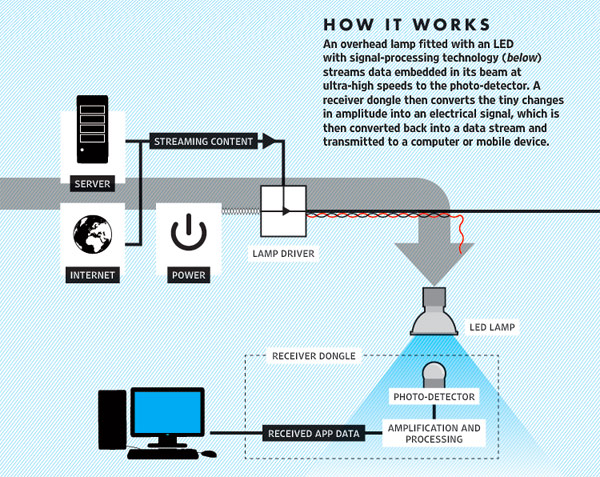Did you know that there is a different wireless network to Wi-Fi?

Li-Fi, which has been described as the new era of wireless connections, is a method of data transmission more than 100 times faster than traditional Wi-Fi, and it only requires that you turn on a light! With speeds of up to 1GBps, this new technology could enable a high-definition film to be downloaded in seconds.
Where does Li-Fi technology come from?
Li-Fi refers to the term Light Fidelity and it is a form of visible light communication.
Li-Fi is a wireless technology that uses visible light communication or the infra-red and near ultraviolet spectrum rather than radio frequency waves. It is a kind of optical wireless communications technology, and can transmit large amounts of data at an ultra-fast speed.
In other words, it is a wireless communication system similar to Wi-Fi but using light instead of electromagnetic waves. Considering that light speed is incredibly fast… Can you imagine being able to connect to and navigate the Internet at light speed?
Illuminate as well as communicate? How?
Li-Fi communication uses visible light pulses to transfer data. The image below shows the process:

Picture courtesy of PureLiFI.com
A bit of history…
The term Li-Fi was created by Professor Harald Haas from the University of Edinburgh. Haas demonstrated the technology at the TED Global Conference in 2011 (Watch the video HERE).
After introducing the technology Haas started promoting it, setting up a company – PureLiFi – to market Li-Fi products. At the end of 2011, different industry groups and companies formed the Li-Fi Consortium with the objective of establishing the new wireless technology in the market.
What are the advantages of the Li-Fi versus Wi-Fi?
- Speed: Li-Fi is meant to be 5 times faster than Wi-Fi.
- Price: Li-Fi is around 10 times cheaper than Wi-Fi
- Less interference between devices: unlike Wi-Fi, Li-Fi does not interfere with other radio signals, so could be utilised on aircraft and in other places where interference is an issue. Due to the fact that light has no electromagnetic interference, Li-Fi could be of major benefit in hospitals, in applications connecting medical equipment.
- Greater security: Wi-Fi technology penetrates through walls and can be intercepted and used by non-authorised users. Li-Fi allows increased security on local networks as the signal gets blocked by walls.
- Energy efficiency: Li-Fi requires less power to operate than Wi-Fi and therefore is potentially more energy efficient, as well as being cheaper.
- Where there is light, there is Internet! Any light bulb with a Li-Fi device installed can be used as a hotspot or lighting router. This is the case for both indoor and outdoor lighting.
… And the disadvantages?
- It cannot be deployed outdoors in direct sunlight (as this would interfere with its signal)
- The connection can’t travel through walls, which makes the usage limited. The initial use is likely to be applied as a supplement in places where Wi-Fi connections are limited, for example in hospitals.
- It doesn’t work when the light is off. This could imply an increase on the lighting bill as light usage would increase.
- It only works with devices that have a Li-Fi compatible receptors.
What is the future of Li-Fi?
Even though Li-Fi is still in the early stages of development, research is moving forward very fast.
The market for IoT products is rapidly growing, demanding an increased connectivity through devices. As a result of this, faster and heavier data transmission is going be required. While Li-Fi might not completely replace Wi-Fi, it is likely that both technologies could be used in parallel to create more efficient networks.
Li-Fi will soon start to gain popularity; with big companies like Apple already looking at starting to incorporate Li-Fi capabilities to their products.
Have you tried the Li-Fi technologies? Let us know your thoughts in the comments section !
Sources:
- http://www.bbc.co.uk/news/technology-34942685
- http://www.telegraph.co.uk/technology/news/12016196/Li-Fi-100-times-faster-than-Wi-Fi-tests-prove.html
- http://www.forbes.com/sites/bernardmarr/2016/01/12/will-lifi-take-big-data-and-the-internet-of-things-to-a-new-level/
- http://www.ibtimes.co.uk/lifi-internet-first-real-world-usage-boasts-speed-100-times-faster-wifi-1530021
- https://en.wikipedia.org/wiki/Li-Fi
- http://purelifi.com/
